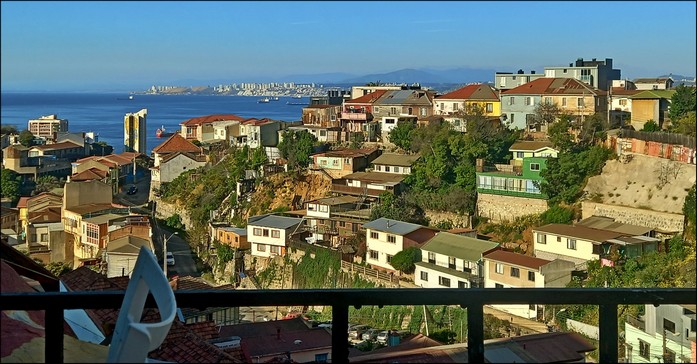
Introduction to Valporaiso, Chile
Valporaiso is one of Chile’s most popular and important coastal cities. Located just 120 km / 75 miles northeast of the capital, Santiago, Valpo makes an easy weekend getaway for city residents.
Valporaiso is famous for its steep hillsides packed with colorful houses, its many amazing panoramic views over the wide bay, its huge port, its colorful bohemian art & cultural scene, its fresh seafood and sandy beaches.
It’s also a cruiseship base and the gateway to Chile’s world-renowned Easter Island, located a very distant 1000 km / 160 miles out in the South Pacific.
With all that on offer, Valpo attracts both weekenders and international travelers to explore its diverse attractions.
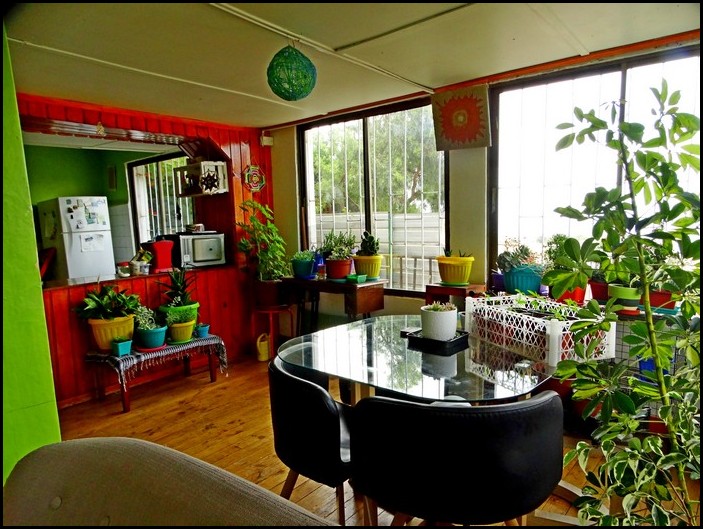
My visit to Valporaiso
I arrived in Valporaiso one week ago and instantly loved the place. I’m staying in a high, vintage hillside house with spectacular views over hills, bay and coast. The home and neighborhood are quiet, peaceful and relaxing.

Geography of Valporaiso
Valporaiso is situated on a vast, wide but shallow bay on the Pacific coast, facing a northwest direction. Thus the sun rises over one side of the bay, crosses over the water all day long, then sets over the hills on the other side of the bay.
The bay is so huge that three distinctive city areas rest along its shores. Valporaiso was founded on the far western side of the bay (more details in the history section below).
There, a flat narrow coastal strip lines the water. Immediately behind that is a long low mountain ridge running parallel to the coast until it ends abruptly at tall cliffs at the far southwestern end of the bay.
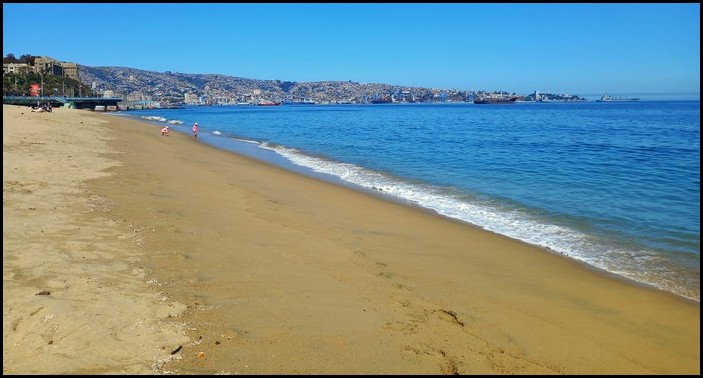
Valporaiso fills the flat coastal strip and also climbs up the long hillside, which is now jam-packed with colorful residential neighborhoods. The imposing international cargo port and cruise ship port are located in Valporaiso, which is where the city was actually founded.
The wide central bay region has several long golden-sand beaches, so it has long attracted vacationers from Santiago and beyond to relax on its sandy shores. This area, called Vina del Mar, has a much larger flatlands, which has become filled with hotels, condos, shopping districts, restaurants and entertainment districts.
Towards the eastern side of the bay, the land rises up into a long low ridge hugging the coast, often dropping down to tall cliffs. Massive sand dunes rise above the ridge. This area, called Concon, is now mostly lined by tall condo towers.
The whole bay area has expanded and grown so much that it has become one massive, completely connected metropolitan area with development lining the entire bay.
Today Valporaiso itself is the sixth-largest city in Chile. But the whole metropolitan area, including Vina del Mar, Concon and other connected areas, is actually Chile’s 2nd largest city.
Historically, vacationers visited Vina del Mar for its beaches, while Valporaiso remained a port, commercial and residential area. But nowadays vacationers and tourists stay at all three areas, each offering a distinctive experience.
Natural disasters in Valporaiso
Over the decades and centuries, Valporaiso has been hit by all sorts of disasters. Several times it was plundered by pirates. Devastating storms, fires and earthquakes have all seriously damaged Valpo at various times.
In terms of earthquakes, for which Chile is particularly prone, the most destructive earthquakes to hit Valpo were in 1906, 1971, 1985 and 2010. Each time Valpo has had to rebuild.
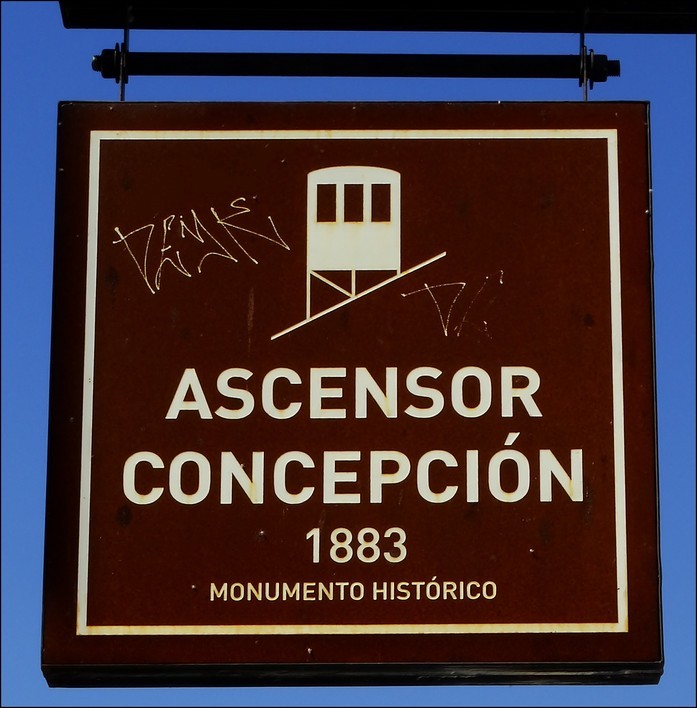
Brief history of Valporaiso
Long before the Spanish arrived in South America, various native tribes lived in the coastal area now occupied by Valporaiso. The city of Valporaiso was founded by Spanish conquistador Juan de Saavedra in 1537, who named it after his hometown in Spain.
But Valpo remained a very small village with a handful of houses and a church for nearly 300 years, until the early 1800s.
In 1810 a wealthy merchant built Chile’s first-ever port at Valporaiso. He continued expanding the blossoming port from 1810-1830. The seaside town gradually became an important port for various Spanish ships coming to/from Europe and around the continent.
In 1817 Chile gained its independence from Spain, becoming the Republic of Chile. The new government immediately created a navy, basing it at Valporaiso, along with a large Naval Academy.
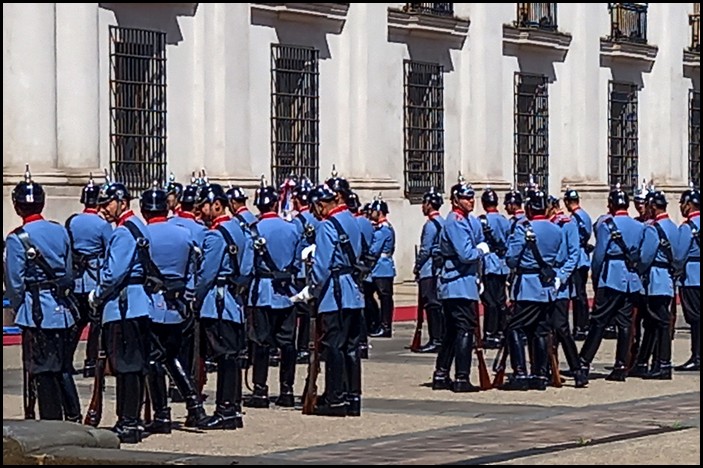
Chile’s independence also allowed it to greatly expand international trade with a plethora of countries. Prior to independence, Spain retained a tight monopoly on all trade.
By the mid-1800s, Valporaiso Port had become the most important port in South America. More and more international trade ships used it as their main base on journeys between the Atlantic and Pacific Oceans.
From the mid-1800s until the early 1900s was Valporaiso’s golden era, when it was dubbed ‘Little San Francisco’ and ‘Jewel of the Pacific’.
The small town expanded out even further from the port, developing into a large commercial, banking and meritime city with more warehouses, government administration buildings, banks and businesses.
The bustling international merchant city attracted many European immigrants, especially from England, Germany, France, Switzerland and Italy. They brought their distinct cultures, cuisines, architecture and educational systems to Valpo, as well as advanced technology. These cultural variations made Valpo a very distinct city in both Chile and South America. Many European traces can still be seen in Valpo today.
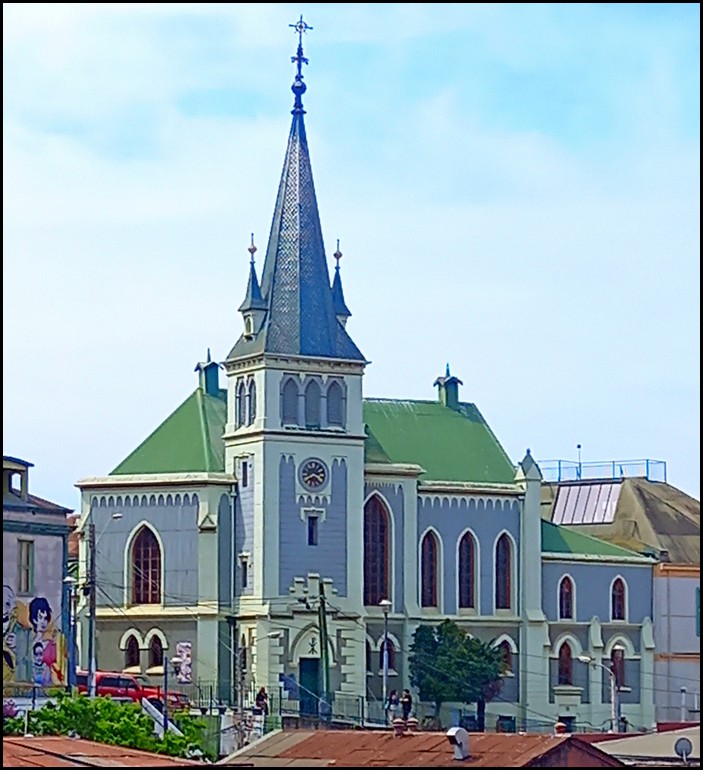
As Valpo continued growing, people began building homes up the hillsides, in a variety of architectural styles introduced from the many European residents. There were several distinctive ethnic neighborhoods, such as the British community that settled Alegre Hill, a French cluster, an Italian enclave, and others.
In terms of cutting edge technology and culture, Valporaiso claimed a lot of firsts for Chile and South America. Valpo had the first telegraphs, telephones, hospital, primary schools, volunteer fire department, potable water, illuminated streets and Latin America’s first stock exchange.
Quite unfortuantely for Port Valporaiso, tragedy struck in 1914. The much-anticipated Panama Canal opened, creating a considerably shorter shipping route between the Atlantic and Pacific.
Almost immediately, Valporaiso’s shipping industry deteriorated. As a result, most wealthy residents left for Santiago or elsewhere. Valpo fell into decline.
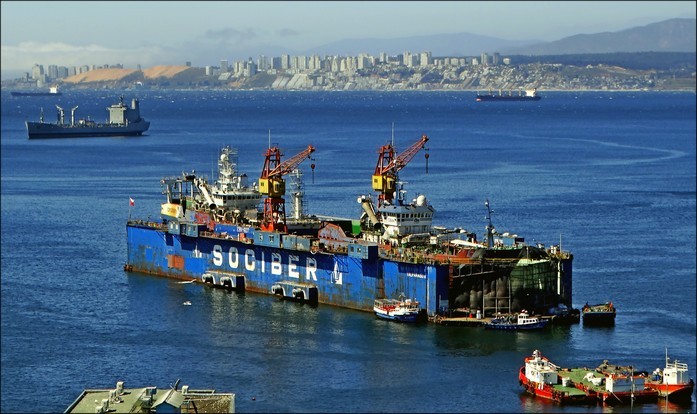
However, the Chilean Navy remained, as did some amount of international trade and shipping stop overs.
In the mid 1900s artists gradually began moving in to Valporaiso. Art, music, literature, trendy cafes, bars and restaurants blossomed.
Meanwhile, further along the bay at a region called Vina del Mar, which is blessed with several long sandy beaches, vacation tourism began growing. It’s close proximity to Santiago made it the perfect place for Santiagoans to escape to the seaside for weekend retreats.
In more recent decades, revitilization projects in Valporaiso have further encouraged & supported local artists, musicians and drive tourism to Valpo and Vina del Mar.
With the ever-growing popularity of cruiseships, Valpo became the perfect lay-over stop. Passengers can easily explore Valpo’s historic district and colorful hillsides.
Nowadays, as noted above, Valporaiso (including Vina del Mar and Concon) is one of Chile’s most famous, popular and important tourist & vacation destination for international and domestic travelers.
Valporaiso’s many attractions and claims to fame

Colorful hillsides & neighborhoods
In terms of tourist appeal, Valporaiso is probably most famous for its colorful historic houses jam-packed up and down its long hillsides.
Several distinctive residential neighborhoods can be visited, each with a slightly different cultural history, architecture and establishments. There’s Alegra Hill, originally a British enclave, Carcel Hill (location of the old prison, now a cultural center), Florida Hill, Polanca Hill,

Panoramic bay & city views
Jaw-dropping panoramic bay views are an integral part of the Valporaiso experience. Just about anywhere you stand or walk in the bay area, whether its along the coast or up in the hills, you’re confronted with spectacular views.
Depending on exactly where you’re situated, you’ll be gazing at some combination of the vast bay; massive cargo ships, cruise ships, tug boats, gray naval vessels and other smaller boats; the huge mounded sand dunes way across the bay in Concon; colorful hillsides; the imposing port with its tall yellow cranes and piles of bright cargo containers.
If you’re staying up on the hillside, you’ll surely also have incredible panoramic views from your hotel or guest house, and probably from your room as well.
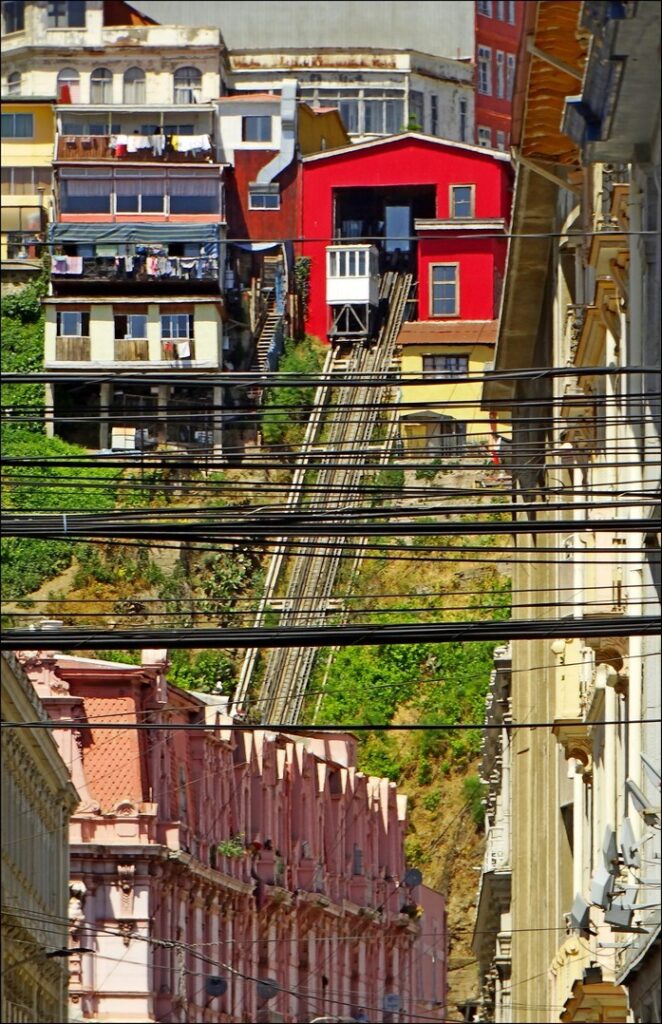
Funiculars
Situated all over the Valporaiso hills are a total of 17 historic funiculars. At least 12 of them are still functioning. Most have their original stations, wooden cars, gears and tracks (well-maintained, of course).
Most of the funiculars are quite short, but still greatly help residents and visitors get up and down the steep hillsides. Riding a funicular is also a charming, nostalgic treat, which can’t be experienced many places in the world. Another of Valporaiso’s most popular attractions.
At just 100 Chilean pesos per ride (about 12-15 cents US), they’re also incredibly affordable.

Valporaiso Port
container ships & cruise ships
Valporaiso Port is once again a thriving international port for cargo ships and cruiseships. The cargo ship wharfs are generally filled with high stacks of containers just unloaded or waiting to be loaded onto the massive cargo ships that are continually coming and going. Several huge, tall cranes are in place to move the containers between ships and wharf.
This port send exports from Chile, such as copper, grapes, wine and fruits off to North America and Europe. It also receives imports from all over the world.
The public is not allowed to enter the cargo ship area, but they can see all the activity of the colorful cranes, containers and ships from a distance.
The public area of the port offers visitors bay trips out on small open boats. The main appeal is being able to view Valporaiso’s vibrant hillsides from a distance and take those iconic photos of the unique city.
Cruiseships have their own wharfs at the port and are seen mostly during Chile’s summer months, December through March.

Historic districts
Valporaiso’s main historic district is situated directly behind the port. Plaza Sotomayer is the centerpiece, surrounded by some of the most beautiful, elaborate historic buildings in the city.
Streets spread out from there, lined by more huge arhitectural beauties, some renovated, some falling to disrepair. A couple blocks away are several massive historic stone bank buildings.
The hillsides are filled with hundreds, or thousands, of other beautiful historic homes and other buildings. Many different architectural styles can be found, due to the diverse international European immigrant scene of the mid-1800s-early 1900s.
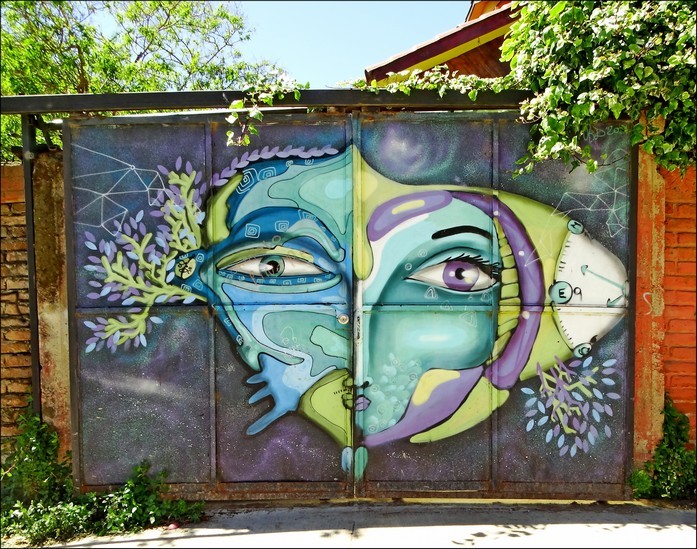
Street art
Valporaiso is almost completely covered in large colorful art murals and graffiti designs. They brighten up nearly every exposed public space: walls, houses, business buildings, park benches and even hospitals.
There’s so much street art in Valpo that it’s almost impossible to walk anywhere without gazing at colorful paintings. It’s so ubiquitous that Valpo has become famous for graffiti and art.
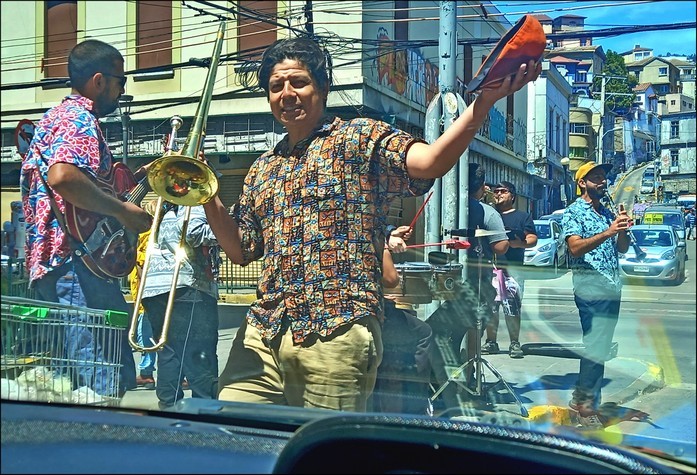
Bohemian culture
Valporaiso’s famed Bohemian culture goes far beyond just graffiti and other street art. There are roving musicians, performers and a large mix of unusual & interesting characters who call Valpo home.
There’s a great music and nightlife scene, trendy cafes & restaurants, flea markets and an ongoing slew of fun events.
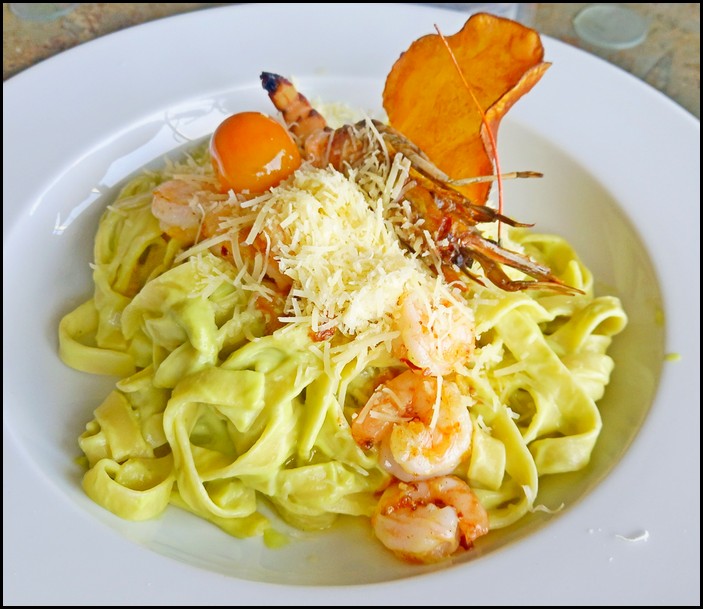
Seafood and dining
Not surprisingly, with its oceanside location and huge port, Valporaiso is also acclaimed for its fresh seafood. Visitors can either dine at the many seafood restaurants or buy fresh fish and shellfish at fish markets to cook at your accommodation.
Portales pier and fish market are located on the coast between Valporaiso and Vina del Mar. It’s easy to reach by a coastal walkway or buses. The huge fish market sells all kinds of freshly-caught seafood.
Chile is also famous for its ceviche (raw fish and/or seafood). Valporaiso and Vina del Mar have several ceviche restaurants, besides the usual cooked seafood places.
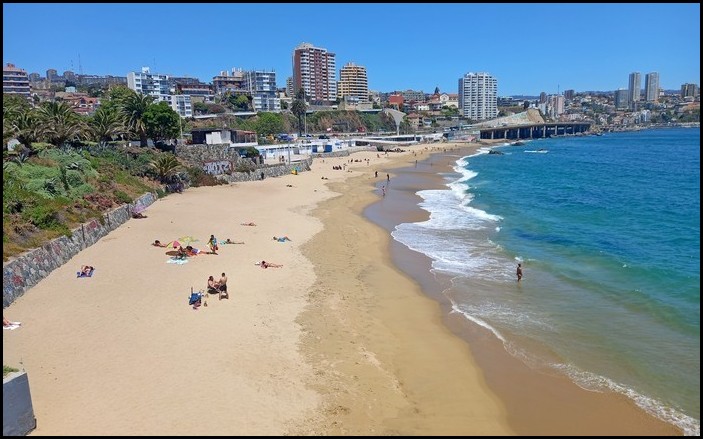
Sandy beaches
Starting at central Valporaiso and heading eastward to Vina del Mar there are a series of golden sand beaches that can be accessed by either walking or taking a bus. From Baron Pier, a wide pedestrian/cycling walkway has been developed along a former warehouse area. It runs all the way to Porales Pier & fish market, situated at the far eastern end of Valporaiso.
From there it’s another coastal walk or bus ride to Vina del Mar, where several long sand beaches line the bay. Although these are city beaches, they are mostly backed by parks or other vegetation, giving them more of a natural setting.
The long golden beaches of Vina del Mar were the main driving force for the area’s development and vacationland reputation. Although they’re certainly closer to Vina del Mar accommodations, it’s pretty quick and easy to reach them for Valporaiso as well.
Summary
By now you can see why Valporaiso and Vina del Mar have become so famous and popular.
If you’re heading to Chile, it’s well-worth visiting this amazing & diverse bay area. Take your pick of the most interesting attractions for yourself and spend a few days – or weeks – enjoying beautiful, colorful Valporaiso.
========================
You might also enjoy:
12 Interesting Facts about Chile
13 Things I Love about South America
=========================








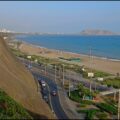
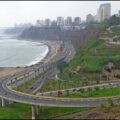


 Hi! I'm Lash, an American nomadic world traveler who's been traveling solo since 1998. I’m passionate about traveling the world nomadically and then sharing it all with you. I hope to inspire you to travel the world, to entertain you with tales from the road, and to help you reach your travel dreams. Welcome!
Hi! I'm Lash, an American nomadic world traveler who's been traveling solo since 1998. I’m passionate about traveling the world nomadically and then sharing it all with you. I hope to inspire you to travel the world, to entertain you with tales from the road, and to help you reach your travel dreams. Welcome! 




1 pings
The 10 Most Spectacular Natural Places in Chile - LashWorldTour
2022/11/29 at 3:44 am (UTC 8) Link to this comment
[…] My Introduction to Valporaiso – Chile […]